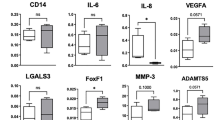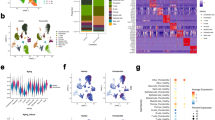Abstract
Periodontal ligament fibroblasts (PDLFs) are integral to the homeostasis of periodontal tissue. The transcription factor Dec1 functions to modulate Porphyromonas gingivalis-induced periodontal inflammation. Here, we aimed to characterize the Dec1-mediated autophagy in PDLFs under inflammatory conditions. Human PDLFs were subjected to an inflammatory environment using P. gingivalis Lipopolysaccaride (LPS) along with Dec1 siRNA in vitro. Quantitative real-time polymerase chain reaction and Western blot analyses were used to evaluate the expression levels of autophagy-related genes and their upstream AKT/mTOR signaling pathways. An experimental P. gingivalis-treated Dec1 knockout (Dec1KO) mouse model was used to confirm the expression of autophagy in PDLFs in vivo. Treatment with P. gingivalis LPS induced the expression of ATG5, Beclin1 and microtubule-associated protein 1 light chain 3 (LC3) and elevated the expression of pro-inflammatory cytokine IL-1β and Dec1 in human PDLFs. Knockdown of Dec1 partly reversed the detrimental influences of LPS on these autophagy markers in human PDLFs. The inhibition of autophagy with Dec1 siRNA suppressed the inflammatory effect of AKT/mTOR signaling pathways following treatment with P. gingivalis LPS. P. gingivalis-treated Dec1KO mice partly reduced autophagy expression. These findings suggest that a Dec1 deficiency can modulate the interaction between autophagy and inflammation in PDLFs.





Similar content being viewed by others
Data availability
The datasets used and analyzed in this study are available from the corresponding author (chocolate_yan@yeah.net) on reasonable request.
References
El-Awady AR, Messer RL, Gamal AY, Sharawy MM, Wenger KH, Lapp CA (2010) Periodontal ligament fibroblasts sustain destructive immune modulators of chronic periodontitis. J Periodontol 81:1324–1335
Zhang J, Wang CM, Zhang P, Wang X, Chen J, Yang J, Lu W, Zhou W, Yuan W, Feng Y (2016) Expression of programmed death 1 ligand 1 on periodontal tissue cells as a possible protective feedback mechanism against periodontal tissue destruction. Mol Med Rep 13:2423–2430
Seo BM, Miura M, Gronthos S, Bartold PM, Batouli S, Brahim J, Young M, Robey PG, Wang CY, Shi S (2004) Investigation of multipotent postnatal stem cells from human periodontal ligament. Lancet 364:149–155
Liu J, Ruan J, Weir MD, Ren K, Schneider A, Wang P, Oates TW, Chang X, Xu HHK (2019) Periodontal bone-ligament-cementum regeneration via scaffolds and stem cells. Cells 8:537
Onizuka S, Iwata T (2019) Application of periodontal ligament-derived multipotent mesenchymal stromal cell sheets for periodontal regeneration. Int J Mol Sci 20:2796
Bai Y, Wei Y, Wu L, Wei J, Wang X (2016) C/EBP beta mediates endoplasmic reticulum stress regulated inflammatory response and extracellular matrix degradation in LPS-stimulated human periodontal ligament cells. Int J Mol Sci 17:385
Benakanakere M, Kinane DF (2012) Innate cellular responses to the periodontal biofilm. Front Oral Biol 15:41–55
Matthews BD, Overby DR, Mannix R, Ingber DE (2006) Cellular adaptation to mechanical stress: role of integrins, Rho, cytoskeletal tension and mechanosensitive ion channels. J Cell Sci 119:508–518
Franke RP, Gräfe M, Schnittler H, Seiffge D, Mittermayer C, Drenckhahn D (1984) Induction of human vascular endothelial stress fibres by fluid shear stress. Nature 307:648–649
Lapaquette P, Guzzo J, Bretillon L, Bringer MA (2015) Cellular and molecular connections between autophagy and inflammation. Mediators Inflamm 2015:398483
Bullon P, Cordero MD, Quiles JL, Ramirez-Tortosa MC, Gonzalez-Alonso A, Alfonsi S, García-Marín R, Miguel MD, Battino M (2012) Autophagy in periodontitis patients and gingival fibroblasts: unraveling the link between chronic diseases and inflammation. BMC Med 10:122
An Y, Liu W, Xue P, Zhang Y, Wang Q, Jin Y (2016) Increased autophagy is required to protect periodontal ligament stem cells from apoptosis in inflammatory microenvironment. J Clin Periodontol 43:618–625
Mizushima N, Komatsu M (2011) Autophagy: renovation of cells and tissues. Cell 147:728–741
Levine B, Mizushima N, Virgin HW (2011) Autophagy in immunity and inflammation. Nature 469:323–335
Ba RQ, Liu J, Fan XJ, Jin GL, Huang BG, Liu MW, Yang JS (2020) Effects of miR-199a on autophagy by targeting glycogen synthase kinase 3β to activate PTEN/AKT/mTOR signaling in an MPP +in vitro model of Parkinson’s disease. Neurol Res 42:308–318
Bhawal UK, Ito Y, Tanimoto K, Sato F, Fujimoto K, Kawamoto T, Sasahira T, Hamada N, Kuniyasu H, Arakawa H, Kato Y, Abiko Y (2012) IL-1β-mediated up-regulation of DEC1 in human gingiva cells via the Akt pathway. J Cell Biochem 113:3246–3253
Martínez-Llordella M, Esensten JH, Bailey-Bucktrout SL, Lipsky RH, Marini A, Chen J, Mughal M, Mattson MP, Taub DD, Bluestone JA (2013) CD28-inducible transcription factor DEC1 is required for efficient autoreactive CD4+ T cell response. J Exp Med 210:1603–1619
Jiang X, Tian F, Du Y, Copeland NG, Jenkins NA, Tessarollo L et al (2008) BHLHB2 controls Bdnf promoter 4 activity and neuronal excitability. J Neurosci 28:1118–1130
Miyazaki K, Miyazaki M, Guo Y, Yamasaki N, Kanno M, Honda Z, Oda H, Kawamoto H, Honda H (2010) The role of the basic helix-loop-helix transcription factor Dec1 in the regulatory T cells. J Immunol 185:7330–7339
Zhang F, Suzuki M, Kim IS, Kobayashi R, Hamada N, Sato F, Bhawal UK (2018) Transcription factor DEC1 is required for maximal experimentally induced periodontal inflammation. J Periodontal Res 53:883–893
Inchingolo F, Martelli FS, Isacco CG, Borsami E, Cantore S, Corcioli F et al (2020) Chronic periodontitis and immunity, towards the implementation of a personalized medicine: a translational research on gene single nucleotide polymorphisms (SNPs) linked to chronic oral dysbiosis in 96 caucasian patients. Biomedicines 8:115
Ballini A, Dipalma G, Isacco CG, Boccellino M, Domenico MD, Santacroce L et al (2020) Oral microbiota and immune system crosstalk: a translational research. Biology 9:131
Isacco CG, Ballini A, De Vito D, Diem Nguyen KC, Cantore S, Bottalico L (2020) Rebalance the oral microbiota as efficacy tool in endocrine, metabolic, and immune disorders. Endocr Metab Immune Disord Drug Targets https://www.eurekaselect.com/184302/article. Accessed 29 July 2020.
Memmert S, Damanaki A, Nogueira AVB, Eick S, Nokhbehsaim M, Papadopoulou AK et al (2017) Role of Cathepsin S in periodontal inflammation and infection. Mediators Inflamm 2017:4786170
Ge Y, Huang M, Yao YM (2018) Autophagy and proinflammatory cytokines: interactions and clinical implications. Cytokine Growth Factor Rev 43:38–46
Scott RC, Juhász G, Neufeld TP (2007) Direct induction of autophagy by Atg1 inhibits cell growth and induces apoptotic cell death. Curr Biol 17:1–11
Ye J, Jiang Z, Chen X, Liu M, Li J, Liu N (2017) The role of autophagy in proinflammatory responses of microglia activation via mitochondrial reactive oxygen species in vitro. J Neurochem 142:215–230
Liu J, Wang X, Zheng M, Luan Q (2018) Lipopolysaccharide from Porphyromonas gingivalis promotes autophagy of human gingival fibroblasts through the PI3K/Akt/mTOR signaling pathway. Life Sci 211:133–139
Tanida I, Minematsu-Ikeguchi N, Ueno T, Kominami E (2005) Lysosomal turnover, but not a cellular level, of endogenous LC3 is a marker for autophagy. Autophagy 1:84–91
Maejima Y, Isobe M, Sadoshima J (2016) Regulation of autophagy by Beclin 1 in the heart. J Mol Cell Cardiol 95:19–25
Veskovic M, Mladenovic D, Milenkovic M, Tosic J, Borozan S, Gopcevic K, Labudovic-Borovic M, Dragutinovic V, Vucevic D, Jorgacevic B, Isakovic A, Trajkovic V, Radosavljevic T (2019) Betaine modulates oxidative stress, inflammation, apoptosis, autophagy, and Akt/mTOR signaling in methionine-choline deficiency-induced fatty liver disease. Eur J Pharmacol 848:39–48
Yu X, Long YC, Shen HM (2015) Differential regulatory functions of three classes of phosphatidylinositol and phosphoinositide 3-kinases in autophagy. Autophagy 11:1711–1728
Munson MJ, Ganley IG (2015) MTOR, PIK3C3, and autophagy: signaling the beginning from the end. Autophagy 11:2375–2376
Li P, Shi J, He Q, Hu Q, Wang YY, Zhang LJ, Chan WT, Chen WX (2015) Streptococcus pneumoniae induces autophagy through the inhibition of the PI3K-I/ akt/mTOR pathway and ROS hypergeneration in A549 cells. PLoS ONE 10:e122753
Li Y, Lu L, Luo N, Wang Y, Gao H (2017) Inhibition of PI3K/AKt/mTOR signaling pathway protects against d-galactosamine/lipopolysaccharide-induced acute liver failure by chaperone-mediated autophagy in rats. Biomed Pharmacother 92:544–553
White E, Karp C, Strohecker AM, Guo Y, Mathew R (2010) Role of autophagy in suppression of inflammation and cancer. Curr Opin Cell Biol 22:212–217
Acknowledgements
We would like to thank Professor Yukio Kato for providing Dec1KO mice, Dr. Toyama and Dr. Sato for the P. gingivalis treatment and the staff of the animal facility for care of the mice. We thank Dr. Fujita for technical assistance.
Funding
This work was supported by Grants-in-Aid from the Ministry of Education, Culture, Sports, Science and Technology of Japan and by a Nihon University Multidisciplinary Research Grant for 2018.
Author information
Authors and Affiliations
Contributions
SO, XL, FZ and UKB performed the experiments, XL and UKB wrote the manuscript. SO, XL, FZ and UKB conceived the study and analyzed the data. FZ, NH, YO and UKB designed the animal experiments. NT, ISK, CC, LZ, MM and YL supervised interpretation of the data and critical review of the manuscript. All authors read and approved the final manuscript.
Corresponding authors
Ethics declarations
Conflict of interest
The authors have no conflict of interest to declare.
Ethical approval
All procedures were performed in compliance with the standard principles and guidelines for the care and use of laboratory animals of Animal Ethics Committee of Kanagawa Dental University (Approval No. 12–042).
Additional information
Publisher's Note
Springer Nature remains neutral with regard to jurisdictional claims in published maps and institutional affiliations.
Supplementary Information
Below is the link to the electronic supplementary material.
11033_2021_6162_MOESM1_ESM.tif
Fig. S1 Expression of hypoxia and ROS related proteins was also decreased in Dec1 KO mice compared to WT mice (TIF 23213 KB)
Rights and permissions
About this article
Cite this article
Oka, S., Li, X., Zhang, F. et al. Loss of Dec1 prevents autophagy in inflamed periodontal ligament fibroblast. Mol Biol Rep 48, 1423–1431 (2021). https://doi.org/10.1007/s11033-021-06162-x
Received:
Accepted:
Published:
Issue Date:
DOI: https://doi.org/10.1007/s11033-021-06162-x




